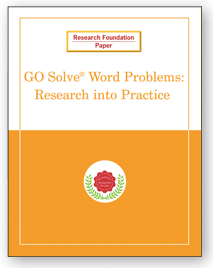Research Foundation
Brian McKean, National Director of Sales at Scholastic/Tom Snyder Productions, explains the five tenets of research behind GO Solve Word Problems. Filmed at the Summer 2009 Technology Leadership Forum at Tom Snyder Productions.
Research into Practice:
GO Solve Word Problems incorporates five research-validated tenets that have been shown to produce good problem-solving habits.
- 1. Schema-based instruction helps develop the ability to generalize problem solving.
GO Solve Word Problems introduces students to the most common types of arithmetical situations reflected in word problems. Students learn to think about categories of problems rather than attacking each problem as a new and separate task. - 2. Drawings and diagrams effectively support the creation of mental models.
GO Solve Word Problems presents a different graphic organizer for each problem situation. Using these diagrams to represent the problem, students gain and retain word problem solving skills. - 3. Animated anchors teach students how to transfer their understanding.
GO Solve Word Problems offers multiple visual examples for each mathematical situation. Students learn to connect the abstract organizers to a range of problem contexts. - 4. Breaking the problem-solving process down into sub-tasks improves mastery of learning.
Students first parse a mathematical situation into the organizer. Next, students identify known and missing information, and finally, students compute the answer. - 5. Personalizing problems enhances motivation and access to problem context.
To make the word problems more relevant and motivating for the students, GO Solve Word Problems allows students to personalize their word problems.


